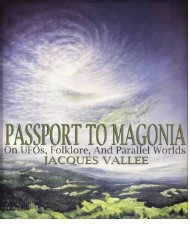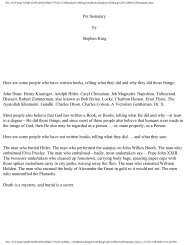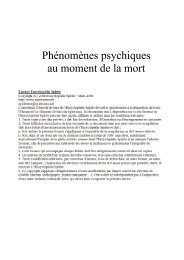extraordinary%20encounters
extraordinary%20encounters
extraordinary%20encounters
Create successful ePaper yourself
Turn your PDF publications into a flip-book with our unique Google optimized e-Paper software.
102 Fairies encountered<br />
sense.” He found his way back to open air,<br />
and the voices and the music ceased (Traum,<br />
1972). Traum’s experience is like many recounted<br />
in the tradition. Fairies are reputed to<br />
drive trespassers off their home turf and, also,<br />
to love music. Both folk fiddlers and at least<br />
one classical composer (Thomas Wood) claim<br />
to have heard fairy music; a nineteenth-century<br />
Manx fiddler, William Cain, was not<br />
alone in learning such a melody and incorporating<br />
it into his repertoire.<br />
The American Indian tribes had their own<br />
versions of fairy traditions, but the Europeans<br />
who settled the North American continent—<br />
except for places where Celtic customs took<br />
firm root, such as Newfoundland—fairly<br />
quickly discarded their own. Nonetheless, occasional<br />
incidents in which fairylike figures<br />
appeared, even if not identified by the witness<br />
as such, have allegedly occurred. All of his life,<br />
Harry Anderson remembered something that<br />
had happened to him one summer night in<br />
1919, when he was walking alone down a<br />
rural road near Barron, Wisconsin. To his<br />
considerable surprise, his solitary stroll was interrupted<br />
by the approach of twenty little<br />
men trooping in single file under the bright<br />
moonlight. They were heading in his direction.<br />
Everything about them was odd: they<br />
were shirtless, bald, pale-faced, and dressed in<br />
leather knee pants. “Mumbling” sounds came<br />
out of their mouths; yet they did not seem to<br />
be talking with each other. As they passed the<br />
young man, they seemed oblivious of or indifferent<br />
to his presence. By now Anderson was<br />
so unnerved that he continued on his way<br />
without ever looking back.<br />
In Canby, Oregon, one day in April 1950,<br />
Ellen Jonerson was working on her lawn when<br />
she happened to glance over at her neighbor’s<br />
yard and saw a bizarre sight: a twelve-inch little<br />
man of stocky build with a tanned face; he<br />
was clad in overalls and plaid shirt. He had<br />
what looked like a skullcap on his head. Jonerson<br />
ran inside to make a quick call about it<br />
to a friend. When she returned, the figure was<br />
walking away with a “waddling” motion. He<br />
passed under a parked car and was seen no<br />
more. At no time did the idea that she was<br />
seeing what some would call a “fairy” enter<br />
Jonerson’s mind, and her report is generally<br />
thought of as a UFO-related close encounter<br />
of the third kind, though no UFO was seen.<br />
Inevitably, some have called UFO encounters<br />
a modern form of fairy belief. Among the<br />
first to do so was Jacques Vallee, author of<br />
Passport to Magonia (1969).Vallee offered an<br />
occult-oriented interpretation that speculated<br />
that an incomprehensible otherworld has interacted<br />
with humankind for thousands of<br />
years, producing manifestations that are filtered<br />
through human consciousness and expectation,<br />
thus changing to reflect different<br />
times and cultures. (Kirk had concluded as<br />
much in the late seventeenth century. Fairies,<br />
of a “middle nature between man and angel,”<br />
dress and speak “like the people and country<br />
under which they live” [Sanderson, 1976].)<br />
Vallee went so far as to declare flatly—if, as<br />
critics charged, hyperbolically—that “the<br />
modern, global belief in flying saucers and<br />
their occupants is identical to an earlier belief<br />
in the fairy-faith. The entities described as the<br />
pilots of the craft are indistinguishable from<br />
the elves, sylphs, and lutins.” Debunkers such<br />
as Robert Sheaffer have employed a different<br />
sort of argument to the effect that flying<br />
saucers and their occupants are as much a<br />
delusion as fairies and fairyland. Neither approach,<br />
however, seems a wholly adequate<br />
way of explaining the mysteries inherent in<br />
such encounters, which paradoxically offer up<br />
“real”-seeming encounters with things that almost<br />
certainly do not exist in the conventional<br />
understanding of the verb.<br />
Fairies have found new life among New<br />
Age visionaries and channelers and other explorers<br />
of the far edges of consciousness. One<br />
writer remarks, “There are two major differences<br />
between the old oral traditional or ancestral<br />
faery contacts and those of contemporary<br />
humanity removed from oral<br />
tradition. . . . The first is that while our ancestors<br />
often sought to break away from the faery<br />
realm, many modern contacts are intentional.<br />
They are induced or encouraged by various





